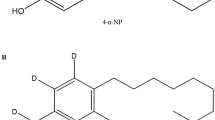Summary
Pharmacokinetics of ranolazine(RAN) in both female and male rats was studied. RAN concentrations in plasma were determined after oral administration of 12.5,25 and 50 mg/kg RAN. Concentrations in tissues, recoveries of RAN in urine and bile were also analyzed following oral dose of 25 mg/kg. It was found that plasma concentrations of RAN in female rats were significantly higher than those in male rats. Drug exposures based on Cmax and AUC in female rats were roughly 2-to-3-fold of those in male rats. Terminate half-life T1/2 and MRT in male rats were shorter than those in female rats.
The recoveries in urine and bile of female rats were also markedly higher than those in male rats’. Tissue concentrations of RAN in female rats were also markedly higher than those in male rats. These results demonstrated existence of marked gender difference in RAN pharmacokinetics in rats.
Similar content being viewed by others
References
McCormack J.G., Barr R.L., Wolff A.A., Lopaschuk G.D. (1996): Ranolazine stimulates glucose oxidation in normoxic ischemic and reperfusion ischemic rat hearts. Circulation. 93, 135–42.
Wang J.X., Maruyama K., Murakami M., Endo T., Komatsu H., Akahane M. (1999): Antianginal effects of ranolazine in various experimental models of angina. Arzneimittelforschung. 49, 193–9.
Pepine C.J., Wolff A.A. (1999): A controlled trial with a novel antis-ischemic agent, ranolazine, in chromic stable angina pectoris that responsive to conventional antianginal agents. Ranoizine study group. Am. J. Cardiol. 84, 46–50.
Bagger J.P., Botker H.E., Thomassen A., Nielsen T.T. (1997): Effects of ranolazine on ischemic threshold coronary sinus blood flow, and myocardial metabolism in coronary artery disease. Cardiovasc. Drugs Ther. 11, 47–84.
Herron W.J., Eadie J., Penman A.D. (1995): Estimation of ranolazine and eleven phase I metabolites in human plasma by liquid chromatography-atmospheric pressure chemical ionisation mass spectrometry with selected-ion monitoring. J. Chromatogr. A. 712, 55–60.
Xie L., Liu X.D., Liang Y., et al. (2003): Determination of ranolazine and its pharmacokinetics in dog by LC-MS. J. Chin. Pharma. Univ. in press.
Liu X.D., Xie L., Zhang Y., Li C.X. (2000): Gender difference in Letrozole pharmacokinetics in rats. Acta Pharmacol. Sin. 21, 680–684.
Los J.K., Welsh D.A., Herold E.G., Bagdon W.J., Zacchel A.G. (1996): Gender difference in toxicokinetics, liver metabolism, and plasma esterase activity; observation from a chronic(27-weeks) toxicity study of enalapril/diltiazem combination in rats. Drugs Metab. Dispos. 24, 28–33.
Gorski J.J., Jines D.R., Haehner-Daniels B.D., Hamman M.A., O’Marar E.M. Jr., Hall S.D. (1998): The contribution of intestinal and hepatic CYP3A to the interaction between midazolam and clarithromycin. Clin. Pharmacol. Ther. 64, 133–43.
Author information
Authors and Affiliations
Additional information
Project supported by: Jiangsu Key Laboratory of Drug Metabolism and Pharmacokinetics
Rights and permissions
About this article
Cite this article
Liu, X., Xie, L., Liang, Y. et al. Gender difference in ranolazine pharmacokinetics in rats. Eur. J. Drug Metab. Pharmacokinet. 28, 119–123 (2003). https://doi.org/10.1007/BF03190499
Received:
Issue Date:
DOI: https://doi.org/10.1007/BF03190499




